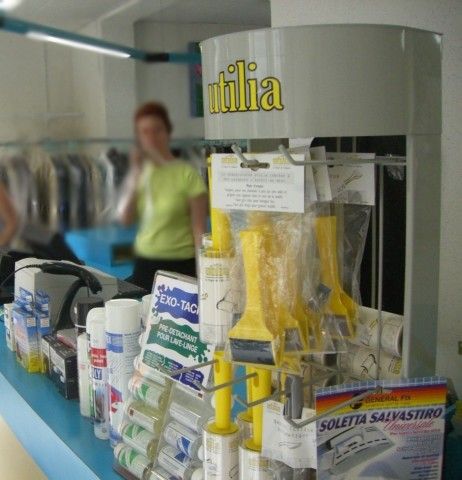Products for sale in dry-cleaning shops:an old story, and yet…
Today, there are mainly 3 kinds of approach concerning products for sale in dry-cleaning shops:
The galactic void
Some old products on a dusty corner of the counter
A true selling section
Do you identify with one of these 3 situations? This article should interest you!.

Why this situation?
Dry-cleaning shops focus on selling services on items dropped off by the customers.
Therefore, selling additional products is not in the DNA of dry-cleaners. All of them have lint rollers in a corner of the counter, but mostly because they need these in the production cycle. If a customer wishes to buy one, why not… but the first intention is not to sell the product.
Retail trade is a specific profession with rules and obligations: orders, purchases, restocks, highlighting, communication, product knowledge, sales pitch, sale. These rules are totally different from the rules related to the dry-cleaning activity.
As a result, sales are very low and bring more issues than real profit.
Bounce effect: no effort is made to increase the volume of additional sales.
>> Vicious circle engaged.
However, some dry-cleaners have understood a basic element which, despite its obviousness, escapes many: a dry-cleaning customer has a fixed and predefined basket. In all modern shops, the goal is to increase the average basket. A customer enters a shop with a buying intention or simply out of curiosity, but can leave with a basket far higher than his initial intention. A dry-cleaning customer going to his neighbourhood shop has the clothes he wants to drop off in his bag. So his basket is predefined. If nothing is proposed, it is hard to ask the customer to take off the clothes he is wearing to increase his basket.

What are the profession’s levers to have an effect on the average basket?
> Sale of additional services:
The idea is to suggest that the customer adds services he didn’t think of in the first place. Here are some ideas:
- Finishing service
- Waterproofing service
- "Quick” service
- "Luxury” service
> Possible little sewing works
Sewing of a missing button, fix of partly undone hem, etc.
> Home delivery services:
Any kind of service that could be related to products dropped off in the first place.
> Additional products sale (topic developed in this article)
- Stain removers
- Anti-moth products
- Waterproofing sprays
- Stockings and socks
- Leather care products
- Detergent products
Keys to success of a selling section
The following assessments match the basic marketing rules:
A selling section must be well-stocked
If there is only one item of a product, it won’t be sold: customers like choice!A product must be attractive
If products look faded, they won’t be sold!The selling section must be easy to reach
If products are located on a corner of the counter and not easy to reach for customers waiting their turn, they won’t be sold!Products must be highlighted
If no information concerning price and function is available, products won’t be sold!
> Food for thought <
Most of dry-cleaners proclaim the following truth:
- No sale = no effort to sell
- “It is useless to make efforts to sell additional products because no one buys them anyway”
What if it was the opposite?
- No effort to sell = no sale
- Some dyers have perfectly understood this, but they are far from representing the majority of the profession.
Our suggestions to have a successful selling section!
What key factors of success?
- A well-lighted selling section
- An easy to reach section by all customers
- The section must be well-stocked: avoid being out of stock, avoid having only one item of a product, avoid the void!
- Prices must be perfectly visible
- Display as much information about products as possible: flyers, TV screen, posters, etc.
- Regular promotions may be implemented: they allow to engage the selling process for the customers who were not initially willing to buy this kind of products in a dry-cleaning shop. For example, a sample given to a loyal customer when he drops off an item can encourage him to purchase this kind of product later.
- A well-structured sales pitch: speak of the products with enthusiasm, know your products perfectly. With good arguments, the customer won’t be able to live without them anymore.
- Do demonstrations: this is the opportunity to show your expertise, which gives you a great added value!
About your added value:
The products you selected must be particular and attractive! You have an advice role as a wise professional!
Indeed, there is a big difference between buying a stain remover in a supermarket and buying the equivalent at your neighbourhood dry-cleaner’s.
The time of relations between customers and shopkeepers, communication and also the professionalism of each profession comes back in force, as we can see it notably in the catering profession. The consumer society changes and comes back to real values: this supports us in our practice, reinforces our passion and reminds us why we like it so much.
Advice is essential. The seller shouldn’t hesitate to suggest a product to each customer recovering his belongings, according to his life style and consumption. He must do it with tact and subtlety, so that the customer feels a real need rather than an obligation to buy. The seller must know his products perfectly, and test them in order to be convinced of their efficiency, then he will be an excellent seller.
How can an IT management tool help?
Available stock management
Each selling and restocking operation will keep the available products quantity up to date, with clear and visible information along the selling process. The internal use of products for production purpose is integrated in this process. It is possible to use directly the barcodes for the sales.
Restocking management
The automatic generation of orders of products in sale to suppliers, in function of needs and technical characteristics (minimum order quantity, unit quantity per package), will allow you to manage your orders by a simple click.
Visibility on sales
Sales reports will allow you to know precisely which are the most sold products and when. This will enable you to target your efforts in terms of communication and promotion.
Visibility on profitability
You will know any moment what is the real profitability of all the sales of these products.
Active communication
An additional information message can be sent to the customer any time he receives an email or SMS alert. The use of a “double screen” display toward the customer enables to broadcast information about products sold.
And tomorrow… toward a direct management of the stock by the supplier?
You don’t have time to manage the products for sale? Leave it to your supplier.
He receives a regular report of sales and stocks.
This allows him to:
- Invoice your consumption > You only pay for what you sell or use
- Send you a restock > You automatically receive the products to put on the shelves, according to the available stock.
Your only role? Keep your shelves well-stocked with received products. Train your staff to sell textile care products (selling technique) and implement incentives (promotion, free product…).

Little conclusion
If you follow these pieces of advice… your shop will become an even more welcoming place!
Of course, your customers will still come with a precise goal (drop off or recover their clothes), but also to find answers and solutions from a professional: care advice, quick alterations, quality products…
Your shop will then become a real communication place and will include all the aspects of the dyer profession.
It’s up to you! Rollers and stain removers are on your side! ;)
Authors: Pascal Berardozzi, in collaboration with Eric Revuelta, customer adviser at Aeschbach Chaussure Genève
Dry-cleaning: how to manage and highlight products for sale?